(ns foundations.computational.linguistics
(:require [reagent.core :as r]
[reagent.dom :as rd]
[clojure.zip :as z]
[clojure.pprint :refer [pprint]]
[clojure.string :refer [index-of]]
;[clojure.string :as str]
))
(enable-console-print!)
(defn log [a-thing]
(.log js/console a-thing))
(defn render-vega [spec elem]
(when spec
(let [spec (clj->js spec)
opts {:renderer "canvas"
:mode "vega"
:actions {
:export true,
:source true,
:compiled true,
:editor true}}]
(-> (js/vegaEmbed elem spec (clj->js opts))
(.then (fn [res]
(. js/vegaTooltip (vega (.-view res) spec))))
(.catch (fn [err]
(log err)))))))
(defn vega
"Reagent component that renders vega"
[spec]
(r/create-class
{:display-name "vega"
:component-did-mount (fn [this]
(render-vega spec (rd/dom-node this)))
:component-will-update (fn [this [_ new-spec]]
(render-vega new-spec (rd/dom-node this)))
:reagent-render (fn [spec]
[:div#vis])}))
;making a histogram from a list of observations
(defn list-to-hist-data-lite [l]
""" takes a list and returns a record
in the right format for vega data,
with each list element the label to a field named 'x'"""
(defrecord rec [category])
{:values (into [] (map ->rec l))})
(defn makehist-lite [data]
{
:$schema "https://vega.github.io/schema/vega-lite/v4.json",
:data data,
:mark "bar",
:encoding {
:x {:field "category",
:type "ordinal"},
:y {:aggregate "count",
:type "quantitative"}
}
})
(defn list-to-hist-data [l]
""" takes a list and returns a record
in the right format for vega data,
with each list element the label to a field named 'x'"""
(defrecord rec [category])
[{:name "raw",
:values (into [] (map ->rec l))}
{:name "aggregated"
:source "raw"
:transform
[{:as ["count"]
:type "aggregate"
:groupby ["category"]}]}
{:name "agg-sorted"
:source "aggregated"
:transform
[{:type "collect"
:sort {:field "category"}}]}
])
(defn makehist [data]
(let [n (count (distinct ((data 0) :values)))
h 200
pad 5
w (if (< n 20) (* n 35) (- 700 (* 2 pad)))]
{
:$schema "https://vega.github.io/schema/vega/v5.json",
:width w,
:height h,
:padding pad,
:data data,
:signals [
{:name "tooltip",
:value {},
:on [{:events "rect:mouseover", :update "datum"},
{:events "rect:mouseout", :update "{}"}]}
],
:scales [
{:name "xscale",
:type "band",
:domain {:data "agg-sorted", :field "category"},
:range "width",
:padding 0.05,
:round true},
{:name "yscale",
:domain {:data "agg-sorted", :field "count"},
:nice true,
:range "height"}
],
:axes [
{ :orient "bottom", :scale "xscale" },
{ :orient "left", :scale "yscale" }
],
:marks [
{:type "rect",
:from {:data "agg-sorted"},
:encode {
:enter {
:x {:scale "xscale", :field "category"},
:width {:scale "xscale", :band 1},
:y {:scale "yscale", :field "count"},
:y2 {:scale "yscale", :value 0}
},
:update {:fill {:value "steelblue"}},
:hover {:fill {:value "green"}}
}
},
{:type "text",
:encode {
:enter {
:align {:value "center"},
:baseline {:value "bottom"},
:fill {:value "#333"}
},
:update {
:x {:scale "xscale", :signal "tooltip.category", :band 0.5},
:y {:scale "yscale", :signal "tooltip.count", :offset -2},
:text {:signal "tooltip.count"},
:fillOpacity [
{:test "isNaN(tooltip.count)", :value 0},
{:value 1}
]
}
}
}
]
}))
(defn hist [l]
(-> l
list-to-hist-data
makehist
vega))
; for making bar plots
(defn list-to-barplot-data-lite [l m]
""" takes a list and returns a record
in the right format for vega data,
with each list element the label to a field named 'x'"""
(defrecord rec [category amount])
{:values (into [] (map ->rec l m))})
(defn makebarplot-lite [data]
{
:$schema "https://vega.github.io/schema/vega-lite/v4.json",
:data data,
:mark "bar",
:encoding {
:x {:field "element", :type "ordinal"},
:y {:field "value", :type "quantitative"}
}
})
(defn list-to-barplot-data [l m]
""" takes a list and returns a record
in the right format for vega data,
with each list element the label to a field named 'x'"""
(defrecord rec [category amount])
{:name "table",
:values (into [] (map ->rec l m))})
(defn makebarplot [data]
(let [n (count (data :values))
h 200
pad 5
w (if (< n 20) (* n 35) (- 700 (* 2 pad)))]
{
:$schema "https://vega.github.io/schema/vega/v5.json",
:width w,
:height h,
:padding pad,
:data data,
:signals [
{:name "tooltip",
:value {},
:on [{:events "rect:mouseover", :update "datum"},
{:events "rect:mouseout", :update "{}"}]}
],
:scales [
{:name "xscale",
:type "band",
:domain {:data "table", :field "category"},
:range "width",
:padding 0.05,
:round true},
{:name "yscale",
:domain {:data "table", :field "amount"},
:nice true,
:range "height"}
],
:axes [
{ :orient "bottom", :scale "xscale" },
{ :orient "left", :scale "yscale" }
],
:marks [
{:type "rect",
:from {:data "table"},
:encode {
:enter {
:x {:scale "xscale", :field "category"},
:width {:scale "xscale", :band 1},
:y {:scale "yscale", :field "amount"},
:y2 {:scale "yscale", :value 0}
},
:update {:fill {:value "steelblue"}},
:hover {:fill {:value "green"}}
}
},
{:type "text",
:encode {
:enter {
:align {:value "center"},
:baseline {:value "bottom"},
:fill {:value "#333"}
},
:update {
:x {:scale "xscale", :signal "tooltip.category", :band 0.5},
:y {:scale "yscale", :signal "tooltip.amount", :offset -2},
:text {:signal "tooltip.amount"},
:fillOpacity [
{:test "isNaN(tooltip.amount)", :value 0},
{:value 1}
]
}
}
}
]
}))
(defn barplot [l m]
(vega (makebarplot (list-to-barplot-data l m))))
; now, for tree making
;(thanks to Taylor Wood's answer in this thread on stackoverflow:
; https://stackoverflow.com/questions/57911965)
(defn count-up-to-right [loc]
(if (z/up loc)
(loop [x loc, pops 0]
(if (z/right x)
pops
(recur (z/up x) (inc pops))))
0))
(defn list-to-tree-spec [l]
""" takes a list and walks through it (with clojure.zip library)
and builds the record format for the spec needed to for vega"""
(loop [loc (z/seq-zip l), next-id 0, parent-ids [], acc []]
(cond
(z/end? loc) acc
(z/end? (z/next loc))
(conj acc
{:id (str next-id)
:name (str (z/node loc))
:parent (when (seq parent-ids)
(str (peek parent-ids)))})
(and (z/node loc) (not (z/branch? loc)))
(recur
(z/next loc)
(inc next-id)
(cond
(not (z/right loc))
(let [n (count-up-to-right loc)
popn (apply comp (repeat n pop))]
(some-> parent-ids not-empty popn))
(not (z/left loc))
(conj parent-ids next-id)
:else parent-ids)
(conj acc
{:id (str next-id)
:name (str (z/node loc))
:parent (when (seq parent-ids)
(str (peek parent-ids)))}))
:else
(recur (z/next loc) next-id parent-ids acc))))
(defn maketree [w h tree-spec]
""" makes vega spec for a tree given tree-spec in the right json-like format """
{:$schema "https://vega.github.io/schema/vega/v5.json"
:data [{:name "tree"
:transform [{:key "id" :parentKey "parent" :type "stratify"}
{:as ["x" "y" "depth" "children"]
:method {:signal "layout"}
:size [{:signal "width"} {:signal "height"}]
:type "tree"}]
:values tree-spec
}
{:name "links"
:source "tree"
:transform [{:type "treelinks"}
{:orient "horizontal"
:shape {:signal "links"}
:type "linkpath"}]}]
:height h
:marks [{:encode {:update {:path {:field "path"} :stroke {:value "#ccc"}}}
:from {:data "links"}
:type "path"}
{:encode {:enter {:size {:value 50} :stroke {:value "#fff"}}
:update {:fill {:field "depth" :scale "color"}
:x {:field "x"}
:y {:field "y"}}}
:from {:data "tree"}
:type "symbol"}
{:encode {:enter {:baseline {:value "bottom"}
:font {:value "Courier"}
:fontSize {:value 14}
:angle {:value 0}
:text {:field "name"}}
:update {:align {:signal "datum.children ? 'center' : 'center'"}
:dy {:signal "datum.children ? -6 : -6"}
:opacity {:signal "labels ? 1 : 0"}
:x {:field "x"}
:y {:field "y"}}}
:from {:data "tree"}
:type "text"}]
:padding 5
:scales [{:domain {:data "tree" :field "depth"}
:name "color"
:range {:scheme "magma"}
:type "linear"
:zero true}]
:signals [{:bind {:input "checkbox"} :name "labels" :value true}
{:bind {:input "radio" :options ["tidy" "cluster"]}
:name "layout"
:value "tidy"}
{:name "links"
:value "line"}]
:width w}
)
(defn tree-depth
"get the depth of a tree (list)"
[list]
(if (seq? list)
(inc (apply max 0 (map tree-depth list)))
0))
(defn tree
"plot tree using vega"
[list]
(let [spec (list-to-tree-spec list)
h (* 30 (tree-depth list))]
(vega (maketree 700 h spec))))
(defn logsumexp [& log-vals]
(let [mx (apply max log-vals)]
(+ mx
(Math/log2
(apply +
(map (fn [z] (Math/pow 2 z))
(map (fn [x] (- x mx))
log-vals)))))))
(defn flip [p]
(if (< (rand 1) p)
true
false))
(defn sample-categorical [outcomes params]
(if (flip (first params))
(first outcomes)
(sample-categorical (rest outcomes)
(normalize (rest params)))))
(defn score-categorical [outcome outcomes params]
(if (empty? params)
(throw "no matching outcome")
(if (= outcome (first outcomes))
(Math/log2 (first params))
(score-categorical outcome (rest outcomes) (rest params)))))
(defn list-unfold [generator len]
(if (= len 0)
'()
(cons (generator)
(list-unfold generator (- len 1)))))
(defn normalize [params]
(let [sum (apply + params)]
(map (fn [x] (/ x sum)) params)))
(defn sample-gamma [shape scale]
(apply + (repeatedly
shape (fn []
(- (Math/log2 (rand))))
)))
(defn sample-dirichlet [pseudos]
(let [gammas (map (fn [sh]
(sample-gamma sh 1))
pseudos)]
(normalize gammas)))
In
Natural Languages and Context-Free Languages, we
gave an example of a construction—from Swiss German—that
could not be captured by a context-free grammar. How are we to capture
such structures?
Our motivation for introducing heads, dependents, and argument
structure was to capture phrasal dependence between constituents in
a sentence. Consider the English verb put. This verb imposes strong
phrasal dependence constraints on sentences in which it appears. Usually
such sentences must contain
phrases expressing: (i) who is doing the putting, (ii) what is
being put, and (iii) the destination of the putting event.
The sentence John put the loaf of bread is incomplete, while
the sentence John put the loaf of bread in his kitchen cupboard
is not.
However, natural language also exhibits constituents that do not
appear to be required by any head word. Consider the sentence While
preparing dinner, John thoughtlessly put the loaf of bread in his
kitchen cupboard. In this sentence, the phrases while preparing
dinner and thoughtlessly specify additional information about the
time and manner of the putting event, but they do not seem to be
required by any other constituent. The sentence is well-formed and
interpretable without them. Moreover, many (perhaps unboundedly many)
modifiers can appear in a sentence. On Tuesday, while preparing
dinner, John thoughtlessly put the loaf of bread in his kitchen
cupboard without noticing the ants in the honey. Such non-argument
phrases are often referred to as modifiers. The critical upshot of
the optionality and iterability of modifiers is that they don’t
seem to be inserted into the sentences using the same
structure-building operations as arguments.
So, for example, it does not seem to make sense to simply list
context-free rules which cover all of the cases above.
(def lexicon
{:S (list
[(li. :S [:N :V]) (/ 1 M)]
[(li. :S [:Adv :N :V]) (/ 1 M)]
[(li. :S [:Adv :Adv :N :V]) (/ 1 M)]
(comment ...) )
:V (list
[(li. :V ['put :N :N]) (/ 1 N)]
[(li. :V ['put :N :N]) (/ 1 N)]
[(li. :V ['put :N :N :P]) (/ 1 N)]
[(li. :V ['put :N :N :P]) (/ 1 2)]
(comment ...))})
If we attempted to cover all possibilities, we would end up with an
unboundedly large set of rules!
What we need is a way to add structure without it being specified by
lexical heads. A standard way to do this in linguistic is via the use
of an operation often called adjunction. Adjunction is thought of as
an operation which “squeezes” a node into a derivation tree.
Consider the following pair of trees.
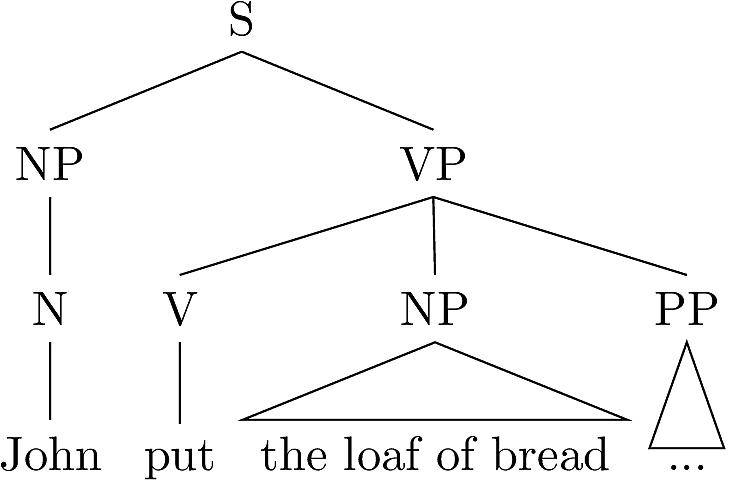

Essentially, we have taken the VP node in the left-hand tree, and squeezed
the following tree fragment into it to make the right-hand tree.
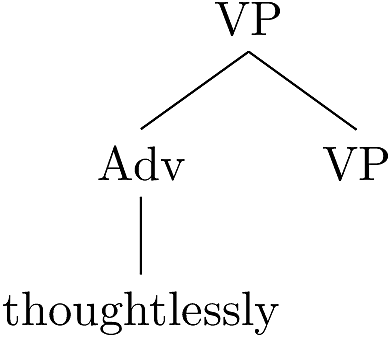
One way of thinking about this is that initial tree is split into a
top and bottom component around the VP node and then the
adjoined tree is inserted into the middle. The node with the * has
been split into a top and bottom component.
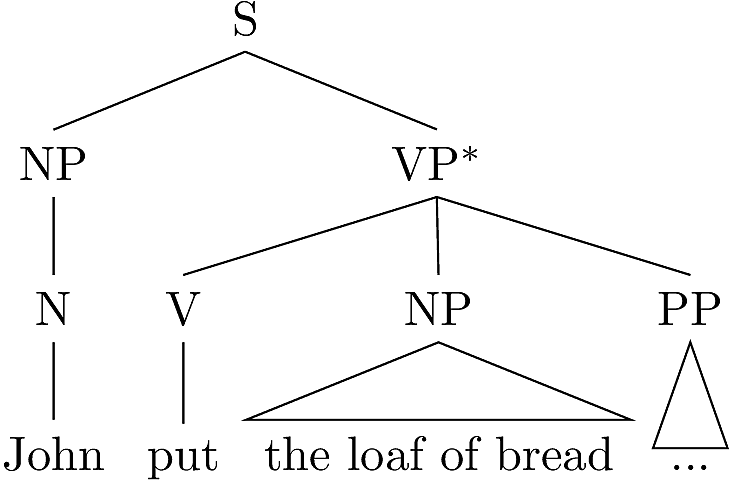
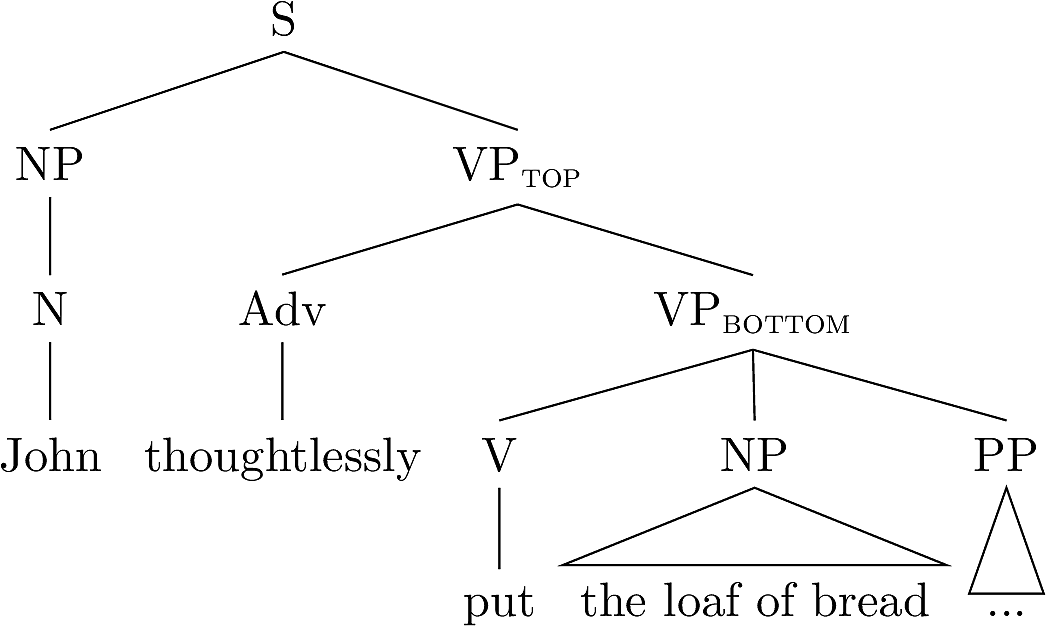
The three components of the new tree are showin below.
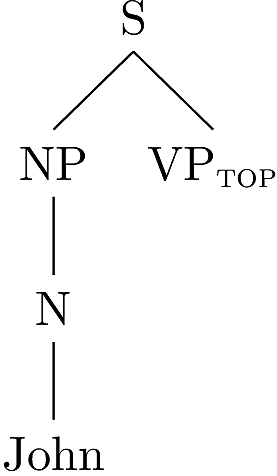
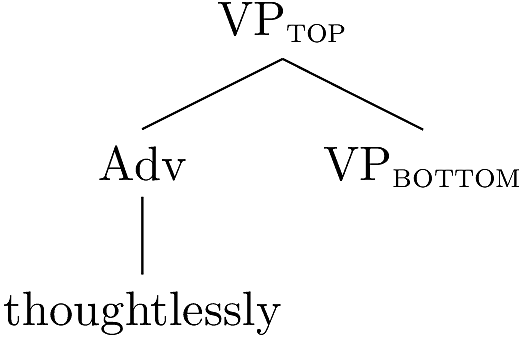
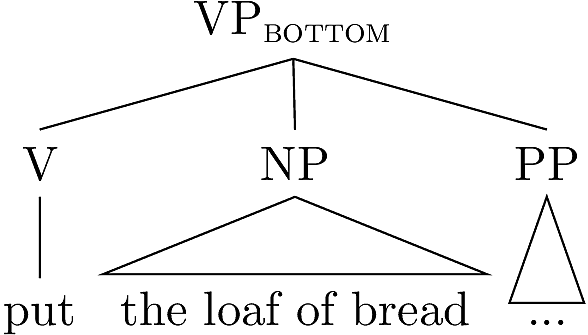
This is a very general operation, which can be schematized as follows.

While the operation of adjunction is useful for capturing the
distinction between arguments and modifiers, it also gives us a
greater degree of formal power. Consider the following fragment of
tree structure.
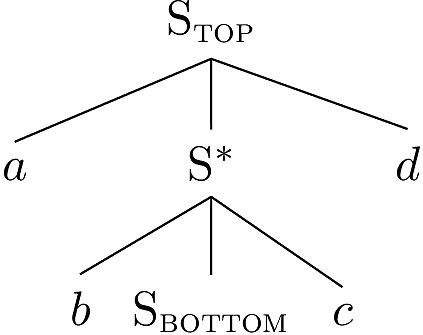
Imagine that this fragment was adjoined into itself at the middle
S node. The result would be the following tree.
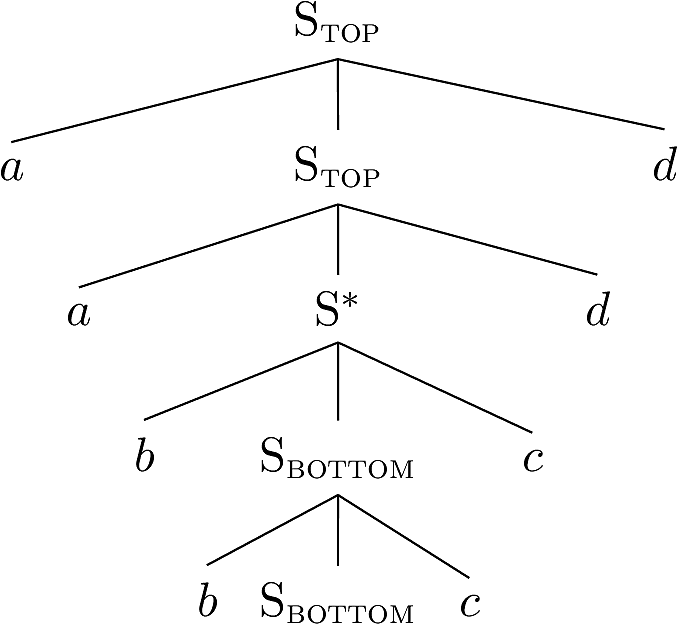
We can adjoin again.
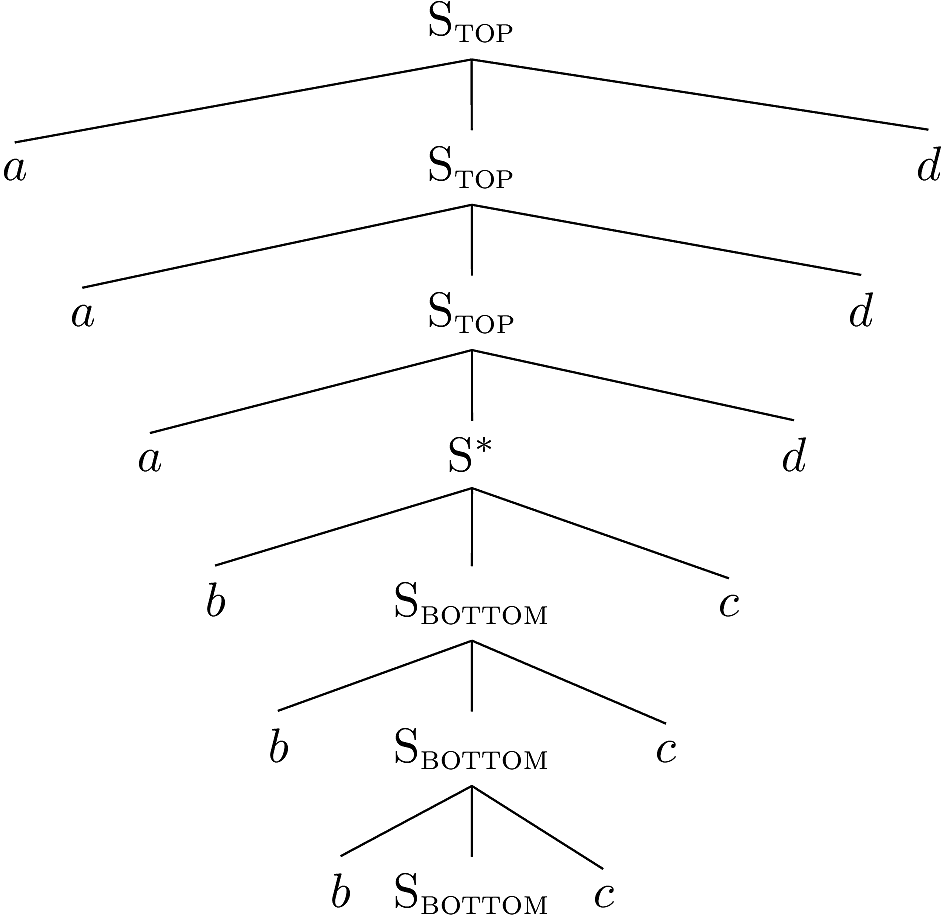
By continually adjoining the tree fragment above into the middle
S node, we can generate the language \(a^n b^n c^n d^n\), a
non-context-free language.
Let’s turn to the case of Swiss German. Can we use adjunction to model
these structures? Consider the following two trees.
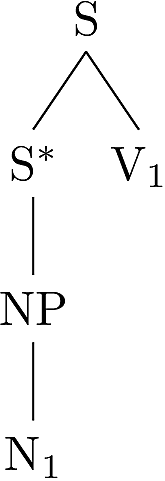
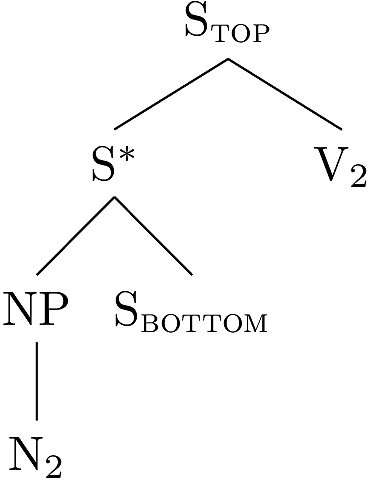

Consider what happens when we adjoin the tree on the right into the
three on the left at the starred node.
← 50 Natural Languages and Context-Free Languages














